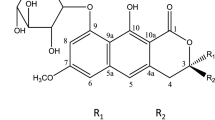Abstract
Three new glycoalkaloids, N-formyl-asimilobine-2-O-β-d-glucoside (1), (−)-1-O-β-d-glucoside-8-oxotetrahydropalmatine (2), and 1-N-monomethylcarbamate-argentinine-3-O-β-d-glucoside (3) were isolated from tubers of Stephania succifera. The structures were established based on spectroscopic analysis, and the antimicrobial activities of the three glycoalkaloids are reported.


Similar content being viewed by others
References
Alley, M.C., D.A. Scudiero, A. Monks, M.L. Hursey, M.J. Czerwinski, D.L. Fine, B.J. Abbott, J.G. Mayo, R.H. Shoemaker, and M.R. Boyd. 1988. Feasibility of drug screening with panels of human tumor cell lines using a microculture tetrazolium assay. Cancer Research 48: 589–601.
Castro, O., J. Lopez, and F.R. Stermitz. 1986. New aporphine alkaloids from Phoebe valeriana. Journal of Natural Products 49: 1036–1040.
Chea, A., S. Hout, S.S. Bun, N. Tabatadze, M. Gasquet, N. Azas, R. Elias, and G. Balansard. 2007. Antimalarial activity of alkaloids isolated from Stephania rotunda. Journal of Ethnopharmacology 112: 132–137.
Choudhary, M.I., M. Ismail, Z. Ali, K. Shaari, N.H. Lajis, and A. Rahman. 2010. Alkaloidal constituents of Tinospora crispa. Natural Product Communications 5: 1747–1750.
Guinaudeau, H., M. Lebouef, and A. Cave. 1994. Aporphinoid alkaloids, V. Journal of Natural Products 57: 1033–1135.
Huang, J.M., and J.X. Guo. 1998. Research progress on the alkaloids from the genus Stephania in China. West China Journal of Pharmaceutical 13: 97–99.
Likhitwitayawuid, K., C.K. Angerhofer, H. Chai, J.M. Pezzuto, G.A. Cordell, and N. Ruangrungsi. 1993. Cytotoxic and antimalarial alkaloids from the tubers of Stephania pierrei. Journal of Natural Products 56: 1468–1478.
Lopez-Martin, J., E.M. Anam, H. Boira, M.J. Sanz, and M.A. Blázquez. 2002. Chromone and phenanthrene alkaloids from Dennettia tripetala. Chemical & Pharmaceutical Bulletin 50: 1613–1615.
Pinho, P.M.M., M.M.M. Pinto, A. Kijjoa, K. Pharadai, J.G. Díaz, and W. Herz. 1992. Protoberberine alkaloids from Coscinium fenestratum. Phytochemistry 31: 1403–1407.
Priestap, H.A. 1989. 13C NMR spectroscopy of aristolochic acids and aristolactams. Magnetic Resonance in Chemistry 27: 460–469.
Shamma, M. 1972. The isoquinoline alkaloids. New York: Academic Press.
Stévigny, C., C. Bailly, and J. Quetin-Leclercq. 2005. Cytotoxic and antitumor potentialities of aporphinoid alkaloids. Current Medicinal Chemistry 5: 173–182.
The Chinese Academy of Science Flora of China Editional Board. 1996. Flora Reipublicae Popularis Sinicae, Tomus 30. Beijing: Science Press.
Verpoorte, R., J. Siwon, M.E.M. Tieken, and A. Baerheim Svendsen. 1981. Studies on Indonesian medicinal plants. V. the alkaloids of Anamirta cocculus. Journal of Natural Products 44: 221–224.
Wang, X.K., and T.F. Zhao. 1989. The alkaloids from the genus Stephania. West China Journal of Pharmaceutical 4: 229–232.
Xu, S.Y., R.L. Bian, and X. Chen. 2003. Methods of pharmacology experiment. Beijing: People’s Sanitation Press.
Yang, D.L., W.L. Mei, H. Wang, and H.F. Dai. 2010. Antimicrobial alkaloids from the tubers of Stephania succifera. Zeitschrift fur Naturforschung 65b: 757–761.
Zhu, Z.Y., Y.X. Feng, L.Y. He, and Y.C. Wang. 1983. Utilization of medicinal plant resources of the genus Stephania of the family Menispermaceae in China. Acta Pharmaceutical Sinica 18: 460–467.
Acknowledgments
This research was financially supported by Special Fund for Agro-scientific Research in the Public Interest (201303117), and National Support Science and Technology Subject (2013BAI11B04).
Conflict of interest
All authors declare no conflict of interest.
Author information
Authors and Affiliations
Corresponding authors
Additional information
Yan-Bo Zeng and Dai-Jing Wei have contributed equally to this study.
Electronic supplementary material
Below is the link to the electronic supplementary material.
Rights and permissions
About this article
Cite this article
Zeng, YB., Wei, DJ., Dong, WH. et al. Antimicrobial glycoalkaloids from the tubers of Stephania succifera . Arch. Pharm. Res. 40, 429–434 (2017). https://doi.org/10.1007/s12272-014-0467-5
Received:
Accepted:
Published:
Issue Date:
DOI: https://doi.org/10.1007/s12272-014-0467-5




